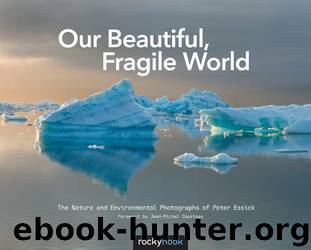Our Beautiful, Fragile World: The Nature and Environmental Photographs of Peter Essick by Peter Essick

Author:Peter Essick
Language: eng
Format: epub
Publisher: Rocky Nook Inc.
Published: 2013-05-14T16:00:00+00:00
The Maldives: A Coral Paradise Slipping Away
“One of the last unspoiled places on Earth, known as the flower of the Indies, has palm-fringed islands, sparkling white beaches, turquoise lagoons, and coral reefs teeming with brilliantly colored fish. It is a unique tropical paradise offering some of the most spectacular dive sites in the world. The largest atoll in the world, Maldives is a garland of emerald islands stretching like a necklace of gems on a vast aquamarine canvas. This is your destination!”
This is how one tourist brochure described this unique country in the Indian Ocean. The Maldives is indeed a spectacular location, and if I were running a tourist resort or dive shop there, I would probably advertise it the same way. However, I had also heard that the coral reefs around the Maldives were suffering from bleaching as a result of increased ocean temperatures. When I arrived on one of the outlying islands and asked the owner of a dive shop if he could show me some of the reefs that were suffering from coral bleaching, he was not too eager to oblige. Although he knew global warming was a threat to the coral, he didn’t want to threaten his own diving enterprise. In the end, he showed me where to find the damaged coral if I promised not to divulge the exact location in the Maldives where I took the photograph.
The Maldives archipelago sits atop a vast submarine mountain range in the Indian Ocean. There are 1,192 coral islands grouped in a double chain of 26 atolls. The atolls are composed of sand bars and living coral reefs, which formed around an underwater volcano over a period of 30 million years. The coral are small animals, or polyps, inside a calcium carbonate shell. These coral have a symbiotic relationship with zooxanthellae—single-celled plants that live within the tissues of polyps and provide organic nutrients. Reef-building corals are more like plants than animals in that they grow using photosynthesis. Coral can utilize sunlight in water depths up to 150 feet. Coral reefs provide habitats for a large diversity of marine organisms, help protect coastlines from erosion, and are a big draw for tourism.
Rising ocean temperatures are threatening coral reefs all around the world. In 1998, a warming of as much as 9 degrees F due to a single El Niño-related event in the Maldives caused coral bleaching that killed two-thirds of the nation‘s coral reefs. Bleaching occurs when the coral under stress push out the symbiotic organisms that contain the colorful pigments. Many of the reefs around the Maldives have re-grown, but the coral can only tolerate so much heat. It is predicted that by the 2030s, 90 % of reefs worldwide will be at risk from both human activities and climate change, and by 2050, all coral reefs will be in danger.
The highest elevation in the Maldives is less than 8 feet above sea level; the lowest of any country on Earth. Given that sea levels have risen 8
Download
This site does not store any files on its server. We only index and link to content provided by other sites. Please contact the content providers to delete copyright contents if any and email us, we'll remove relevant links or contents immediately.
| Photo Essays | Photojournalism |
Shoot Sexy by Ryan Armbrust(17141)
Portrait Mastery in Black & White: Learn the Signature Style of a Legendary Photographer by Tim Kelly(16484)
Adobe Camera Raw For Digital Photographers Only by Rob Sheppard(16387)
Photographically Speaking: A Deeper Look at Creating Stronger Images (Eva Spring's Library) by David duChemin(16161)
Bombshells: Glamour Girls of a Lifetime by Sullivan Steve(13108)
Art Nude Photography Explained: How to Photograph and Understand Great Art Nude Images by Simon Walden(12348)
Perfect Rhythm by Jae(4621)
Pillow Thoughts by Courtney Peppernell(3395)
The Book of Joy by Dalai Lama(3217)
Good by S. Walden(2915)
The Pixar Touch by David A. Price(2739)
Fantastic Beasts: The Crimes of Grindelwald by J. K. Rowling(2543)
A Dictionary of Sociology by Unknown(2518)
Humans of New York by Brandon Stanton(2379)
Read This If You Want to Take Great Photographs by Carroll Henry(2303)
Stacked Decks by The Rotenberg Collection(2270)
On Photography by Susan Sontag(2130)
Photographic Guide to the Birds of Indonesia by Strange Morten;(2088)
Insomniac City by Bill Hayes(2083)
